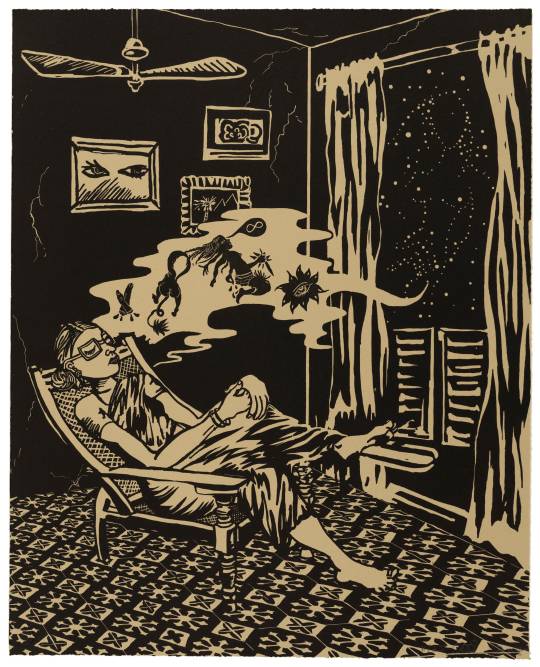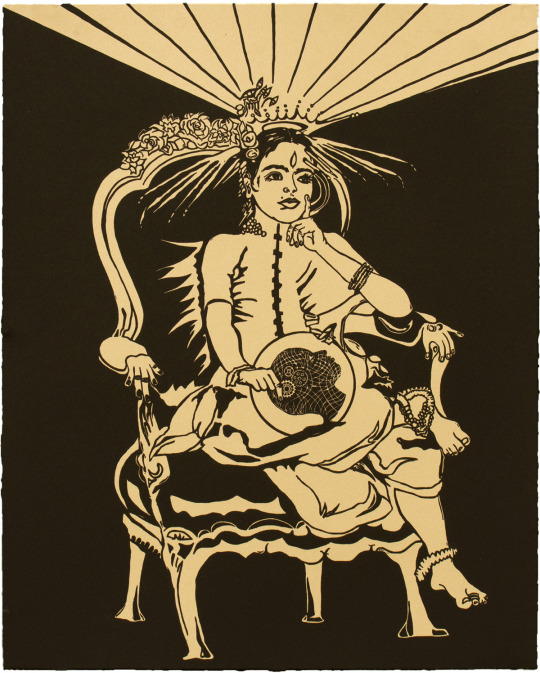#Chitra Ganesh
Photo


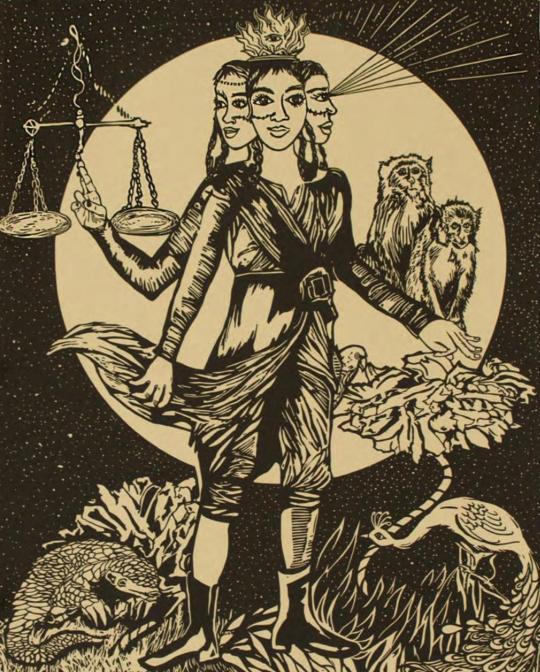

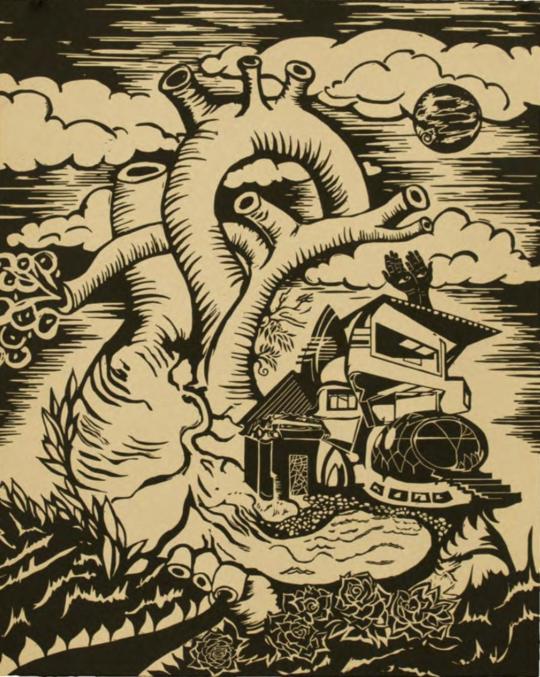


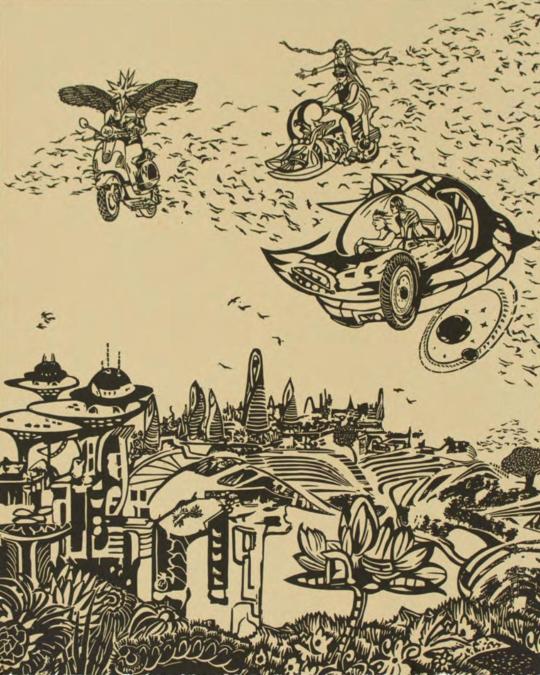
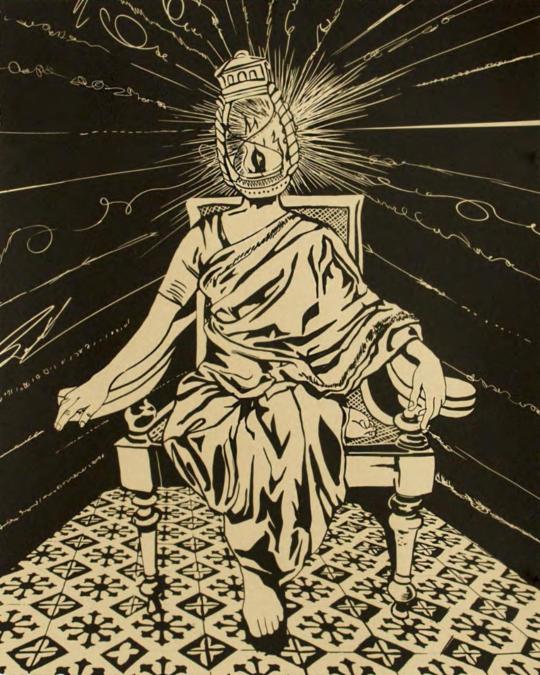

Chitra Ganesh, ''Sultana's Dream'', 2018
Source
“This project is inspired by Sultana’s Dream, a 1905 feminist utopian text written by an early Bengali feminist writer and social reformer, Rokeya Sakhhawat Hossain. Educated thanks to the support of her family, Hossian was one of the few elite Bengali women of her generation writing in English. Sultana’s Dream was written over the course of an afternoon. It was first published in the Ladies’ Journal, a women’s literary magazine based in Madras, appearing some 10 years before Charlotte Perkins Gilman’s iconic feminist utopic novel Herland. Sultana’s Dream, though not as widely known, holds a singular position among early feminist science fiction literature. This series of prints draws on Hossain’s vibrant imagery, translating a story written in verse into a visual grammar that connects with problems that shape 21st century life: apocalyptic environmental disaster, the disturbing persistence of gender-based inequality, the power of the wealthy few against the economic struggles of the majority, and ongoing geopolitical conflicts that cause widespread death and suffering. Created in a form that is historically foundational to the idea of public discourse, this series of works comments through form and content on this fraught moment in world history, demonstrating the enduring relevance of feminist utopia imaginaries in offering an invaluable means of envisioning a more just world.” (Source)
#chitra ganesh#american artists#linocuts#rokeya sakhhawat hossain#sultana's dream#feminist utopia#utopian#early science fiction
145 notes
·
View notes
Text
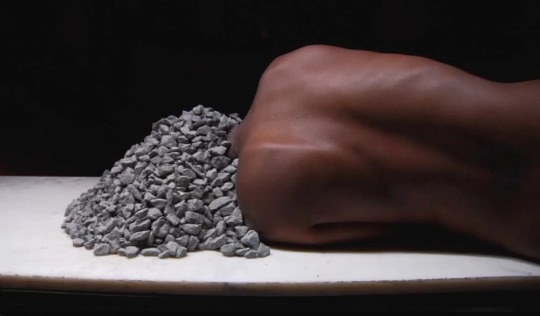
Girl, Simone Leigh, Chitra Ganesh, My Dreams, My Works Must Wait Till After Hell, 2011, single-channel digital video, color, sound; 07:14 minutes, Smithsonian American Art Museum, Museum purchase through the Samuel and Blanche Koffler Acquisition Fund, 2019.33.1, © Girl (Simone Leigh and Chitra Ganesh); Courtesy of the artists and Luhring Augustine, New York
2 notes
·
View notes
Text
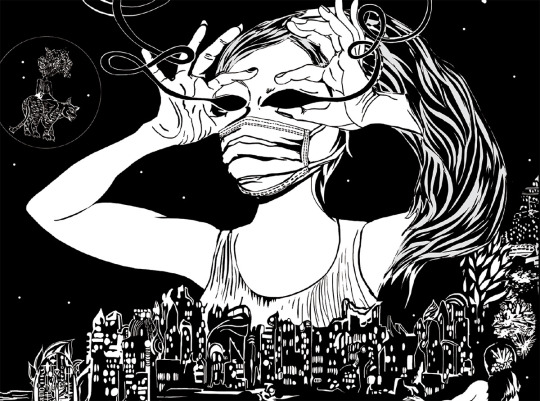

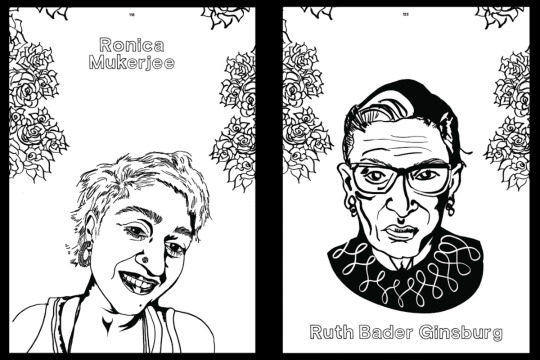
Chitra Ganesh's “Queer Power! A Time Travelling Coloring Book” is dedicated to resisting erasure and honors LGBTQI+ activists and cultural icons.
Read more about the project.
11 notes
·
View notes
Text



TODAY: Opening reception for Resplendent, Identity and Visibility in Comics exhibit at Montserrat College of Art. 🌈✒️
#queer comics#lgbt comic#queer artist#lgbtq positivity#jennifer camper#Bishakh Som#lawrence lindell#Breena Nuñez#A.K. Summers#Chitra Ganesh#Rumi Hara#Paige Braddock#jessica campbell#Raúl the Third#jamila rowser#Robyn Smith#Lavaughan Jenkins#Karmimadeebora McMillan#Edie Fake#Lilli Carré#artists on tumblr#wlw art#queer artwork#trans artist#nonbinary artist#gay art#gay artwork#gay artists
4 notes
·
View notes
Photo
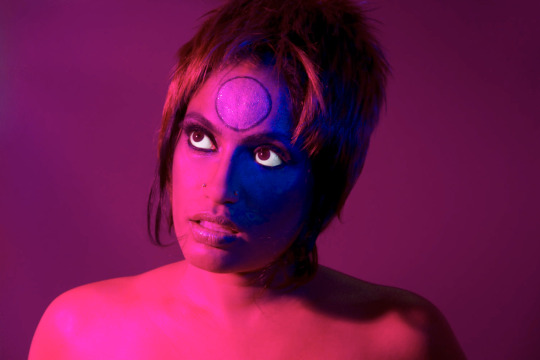
Chitra Ganesh on the Shape-Shifting Commentary of an Artist
How did you begin your practice?
I was fortunate that my parents always encouraged my interest in art, but the prospect of becoming a professional artist seemed impossible to me. Growing up, there was no one in our community who was a practising artist whom I could access as a role model. This changed on becoming involved with the South Asian Women's Creative Collective in the late 1990s and meeting other South Asians who were interested in the arts, some in a professional capacity. My mother also passed away around this time and I started working part-time and making paintings in my apartment.
Excerpt from Chitra Ganesh’s interview.
Text by Shreya Ajmani
0 notes
Text
Mahabharata - A 21st century retelling
Author’s Note: The Mahabharata is a legendary epic. Whatever your religious beliefs are, if you have any appreciation for a good story, you will admit that that the Mahabharat does not disappoint. Now, I’m not exactly Hindu, but I do know a good deal about it. I grew up reading Amar Chitra Katha and I regularly enjoy shocking people with how much I know as a non-religious person. This Ganesh…
View On WordPress
#amar chitra katha#bhishma#custody#ganesh chaturthi#ganga#king shantanu#mahabharat#mahabharata#nandini#shantanu#vashishta
0 notes
Text

Source: A Queer Little History Of Art - by Alex Pilcher
Art: Forever Her First - by Chitra Ganesh
#lesbian history#lesbian art#lesbian positivity#indian lesbians#Indian lesbian positivity#image#photo#lgbt#lesbian#art#personal
135 notes
·
View notes
Text
Central to their production of an alternative archive is what [Mariam] Ghani and [Chitra] Ganesh call their “Warm Database.” Warm data, as Ghani explains, stands in opposition to the “cold hard facts” elicited by official interrogations of the detainees and that are used to produce, discipline, and contain the “terrorist.” To that end, the artists have posted on their website what they term a “Warm Data Questionnaire”; they invite all those who have been “affected by detention and/or deportation” to answer questions such as the following:
Who was the first person you ever fell in love with? What is your favorite flavor, and what is the one food that if you had the choice you would never eat? Which family member are you the closest to? Describe a place you see when you close your eyes at night. Name a piece of music that is always running through your head. What is your earliest childhood memory? Which muscle do you use the most in your normal daily activities?
The artists state that their intention is to collect material or information that would be deemed “useless” and without value in the eyes of the surveillance apparatus; this is precisely the information that is excised or never granted entrance in the first place in the official archive. If what is deemed as “religious fervor” or “anti-Americanism” are the only forms of affect that the security apparatus seeks to elicit and document as “proof” of the detainee’s terrorist status, the “warm data” gathered by Ganesh and Ghani instead constitutes an alternative “archive of feelings,” to use Ann Cvetkovich’s evocative phrase.
Archive, Affect, and the Everyday: Queer Diasporic Re-Visions by Gayatri Gopinath, in Political Emotions
3 notes
·
View notes
Text
Pattachitra Art: Stories in Every Stroke
Pattachitra painting is a form of art that derives its culture from the provinces of the east, specifically West Bengal and Odisha. The ancient temples and shrines of Odisha have their origins from centuries ago. It is believed that the pattachitra artists and their artwork emerged roughly in the 12th century. Pattachitra is one of India's oldest surviving folk art forms. The core of this art form infers from a word that is made up of two expressions derived from the Sanskrit words—“Patta” which is cloth and “Chitra” which refers to the pictures. This eccentric art form has a tradition of integrating paintings that are not only cloth-based but also act as a visual storytelling medium. Often it is accompanied by songs too.
Chitrakar makes pattachitra paintings
“Chitrakars” as the Pattachitra artists are famously known, primarily make idol paintings that are based on mythology. Its popular themes include the Badhia (a depiction of the temple of Jagannath), Krishna Lila (an enactment of Jagannath as Lord Krishna displaying his powers as a child), Dasabatara Patti (the ten incarnations of Lord Vishnu); and Panchamukhi (a depiction of Lord Ganesh as a five-headed deity). The Patua community of artisans is dedicated to creating the Pattachitra artwork. These artisans are called various names such as Patu, Patua or Pota. The living spaces of the Patua community are scattered across West Bengal, Jharkhand, and Odisha in India and some parts are also in Bangladesh. Talking about the current federal initiatives, the government has organized many art festivals or international showcases with the intent of safeguarding and showcasing Pattachitra artwork.
Recognition of artists and their significant role in keeping Pattachitra culture alive
Chalchitra, integral to Bengal Pattachitra, holds significance as the background portrayal of Durga Pratima or idol. Also known as Debi Chal or Durga Chala, it serves as the canvas for the artistic expression of Patuas, who refer to it as Pata Lekha, indicating the writing of Pattachitra. Historically, Chalchitra was utilized in idols dating back 300–400 years in the Nabadwip Shakta Rash tradition. Though it faded for a period, Chalchitra has experienced a resurgence in popularity.
Pattachitra in Durga Puja
Durga Patta(Pot), also known as Durga Sara, holds a distinguished position in Bengal Pattachitra and is recognized as a worshiped form. This particular Pattachitra is revered during Durga Puja in the Hatsarandi Sutradhar society of Birbhum district and Katwa. The hemispherical Durga Patta(Pot)features a central depiction of Durga, surrounded by paintings of Ram, Sita, Shiva, Nandi-Vringi, Shumbha-Nishumbha, and more. This intricate portrayal not only pays homage to religious traditions but also serves as a testament to the artistic brilliance embedded in Bengal Pattachitra.
Pattachita Paintings changing with time
With the passage of time, Pattachitra art too underwent extraordinary transitions. The "Chitrakars" have painted tussar silk, palm leaves, and various other materials in addition to the linen generally painted on. In recent years, Pattachitra has been painted on showpieces, handbags, sarees, wall hangings, and etc. In Spite of their conventional application of vibrant colors and figurines which has stood the test of time through generations although it was never hindered by Pattachitra’s originality.
Creating a Pattachitra involves meticulous preparation
The laborious processes employed in producing Pattachitra paintings, from priming the canvas to incorporating fine details. Use of natural substances including materials, colors derived from plants and minerals, and traditional brushes designed from bamboo or the hair of animals. The artist prepares the canvas by applying a paste made from tamarind seed gum and white stone powder onto a cloth. Natural pigments are then used to bring the figures and scenes to life. Pattachitra is a disciplined art style with guidelines and limitations. Paintings by Pattachitra must include a border with flowers and must use natural colors that are limited to one tone. This results in a unique style and atmosphere that is peculiar to Pattachitra and cannot be duplicated.
Pattachitras are not just beautiful works of art; they serve a deeper purpose. Traditionally, they were used to adorn temples and depict religious narratives for devotees. Today, they are not only collector's items but also a way for artists to preserve and share their cultural heritage. You can also have the pattachitra as one of the traditional heirlooms in your family. Owning a pattachitra painting can also be a source of pride and fascination for family members and visitors alike. Get your favorite Pattachitra atwork here at Dirums.
0 notes
Text

Chitra Ganesh (F ‘19, ‘13, A ‘01)
Inheritance
Whitney Museum of American
Gansevoort St, New York, NY 10014
June 28, 2023 - February 4th, 2024
0 notes
Text

original poem, art by Chitra Ganesh about Sultana’s Dream by Rokeya Sakhawat
0 notes
Text

Chitra Ganesh, The Scorpion Gesture, 2018, suite of 5 digital animations, color, sound; 07:59 minutes, Smithsonian American Art Museum, Museum purchase, in partnership with the Smithsonian Asian Pacific American Center and the Samuel and Blanche Koffler Acquisition Fund, 2022.50, © 2022, Chitra Ganesh
Chitra Ganesh (born 1975) is a visual artist based in Brooklyn, New York. Ganesh's work across media includes: charcoal drawings, digital collages, films, web projects, photographs, and wall murals. Ganesh draws from mythology, literature, and popular culture to reveal feminist and queer narratives from the past and to imagine new visions of the future. Via Wikipedia
0 notes
Text
youtube
Reading Stories of Supernatural Women in Supernatural Time. "Sultana's Dream" written by Begum Rokeya Sakhawat Hossain.
Listen the story with beautiful illustration by Chitra Ganesh. The Goethe-Institut Bangladesh and HerStory Foundation are unlocking übernatural stories to help us get through the lockdown.
As part of the Übernatural: Unlocked on February, 2020 these story was shared on May 28, 2020 (online).
Story reading by Inshra Sakhawat Russell Illustration by IstelaIllustrated I Goethe-Institut Bangladesch Book Illustration by Chitra Ganesh Visual designed by Jolchobi Production
Music by https://www.purple-planet.com/
#fiction#utopia#20th century#video#audio fiction#feminist writing#Sultana's Dream#Begum Rokeya Sakhawat Hossain#Youtube
1 note
·
View note
Text
PATTACHITRA OF ODISHA
PATTACHITRA OF ODISHA
Pattachitra style of painting is one of the oldest and most popular art forms of Odisha. The name
Pattachitra has evolved from the Sanskrit words patta, meaning canvas, and chitra, meaning picture.
Pattachitra is thus a painting done on canvas, and is manifested by rich colourful application, creative
motifs and designs, and portrayal of simple themes, mostly mythological in depiction.
PATTACHITRA AVAILABLE
Some of the popular themes represented through this art form are Thia Badhia – depiction of the temple of
Jagannath; Krishna Lila – enactment of Jagannath as Lord Krishna displaying his powers as a child; Dasabatara
Patti – the ten incarnations of Lord Vishnu; Panchamukhi – depiction of Lord Ganesh as a five-headed deity.
More than anything, the themes are clearly the essence of the art form, conceptualising the meaning of the
paintings. It is no surprise therefore that the process of preparing the paintings engages undeterred concentration
and careful craftsmanship, stretching the preparation time of the patta alone to around five days.
Making the patta is the first thing that comes in the agenda, and the painters, also called chitrakars, go about
their work in preparing a tamarind paste, which is made by soaking tamarind seeds in water for three days. The seeds
are later pounded with a crusher, mixed with water, and heated in an earthen pot to turn it to a paste, which is
called niryas kalpa. The paste is then used to hold two pieces of cloth together with it, and coated with a powder
of soft clay stone a couple of times till it becomes firm. Soon as the cloth becomes dry, the final touch of polishing
it with a rough stone and then a smooth stone or wood is given, until the surface becomes smooth and leathery, and is
all ready as a canvas to be painted on.
Preparing the paints is perhaps the most important part of the creation of Pattachitra, engaging the craftsmanship of the
chitrakars in using naturally available raw materials to bring about indigenous paints. The gum of the kaitha tree is the
chief ingredient, and is used as a base for making different pigments, on which diverse raw materials are mixed for diverse
colours. Powdered conch shells, for instance, are used for making a white pigment, while lamp soot is used for a black pigment.
The root of the keya plant is usually used for making the common brush, while mouse hair is used on the requirement of finer
brushes, to be attached to wooden handles.
The creation of the Pattachitra paintings is a disciplined art form, and the chitrakars maintain rigidity in their use of colours
and patterns, restricting the colours to a single tone. Limiting themselves within the boundaries of some rules, the chitrakars
come up with such remarkable paintings depicting stark emotional expressions that it is a surprise shading of colours is a taboo.
In fact, it is this display of emotions of the figures expressed in the paintings, which is the crème de la crème of the art form,
and the chitrakars put in their best to bring out the most through their rich colourful motifs.
With the passage of time, the art of Pattachitra has gone through a commendable transition, and the chitrakars have painted on
tussar silk and palm leaves, and even created wall hangings and showpieces. However, this kind of innovativeness has never proved
to be a hindrance in their customary depiction of figures and the use of colours, which has remained intact throughout generations.
This constancy is the key factor that has maintained the effervescence of Pattachitra, backed with the fact that the setting up of
some special centres for the art form in Odisha speaks volumes for its popularity.
0 notes
